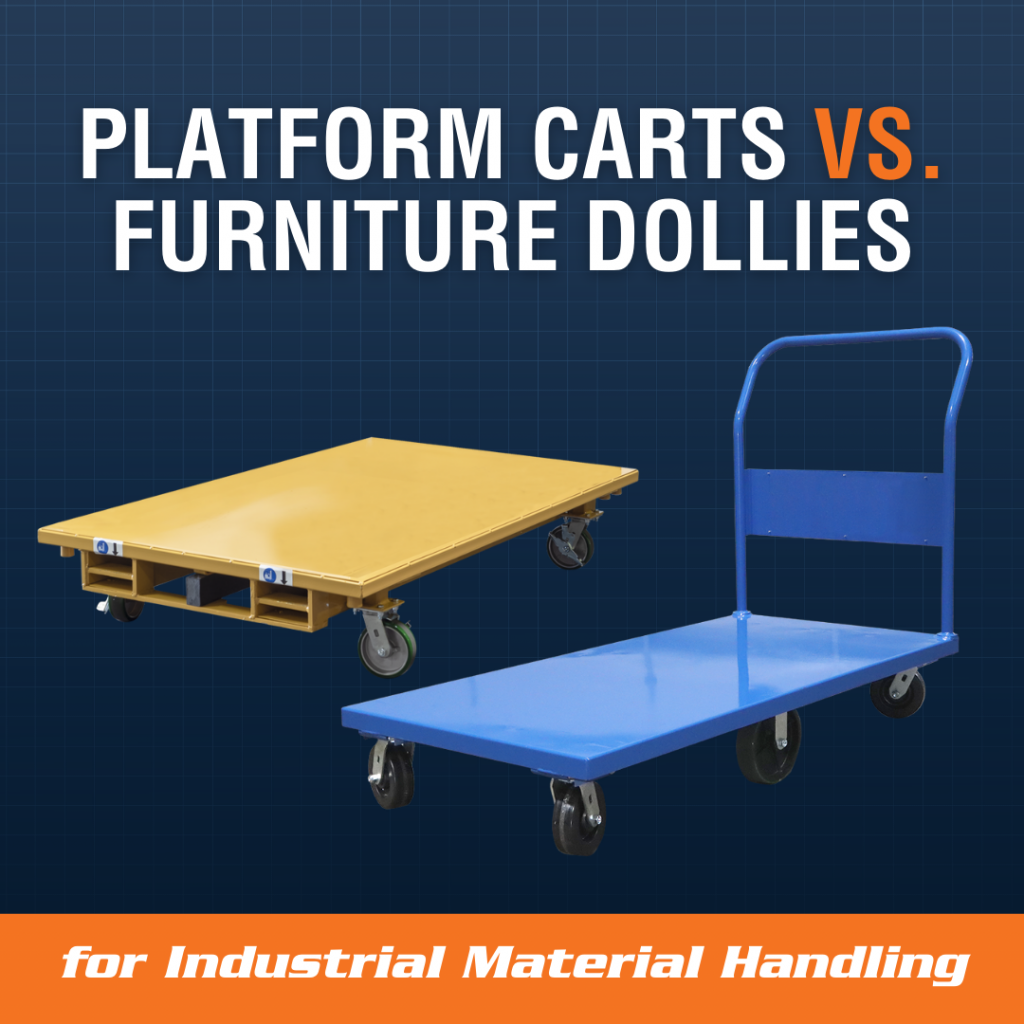We use cookies to make your experience better. To comply with the new e-Privacy directive, we need to ask for your consent to set the cookies. Learn more.
Platform Carts Vs. Furniture Dollies for Industrial Material Handling
Every year between 2015 and 2018, well over 60 percent of warehouse and distribution center operators invested significantly in material handling equipment. That’s not a surprise; handling materials is the core function of these facilities, and unassisted manual material handling can be inefficient, costly, and downright dangerous.

While forklifts and automated guided vehicles may be ideal for moving goods throughout industrial plants, sometimes the right tool for the job is simpler. Sometimes you just need a cart: a hand-pushed, wheeled vehicle that allows a single operator to move high-volume goods or large items.
The question is, what type of cart is ideal for the materials you need to haul? While multi-shelf Stock Picking Carts or Order Picking Carts are ideal for moving consumer packaged goods, they’re not much help with bigger loads. To move large packages, components, or materials, you have two types of carts to choose from: platform carts (like the Flatbed Cart from BHS) and furniture dollies (like BHS’ Flat Deck Cart). Note that “furniture dollies” aren’t just for furniture; they’ll handle anything within capacity. Material handling specialists use the term to differentiate from smaller dollies or hand trucks, which often get stuck with the designation, too.
Here’s what you need to know about the difference between a platform cart and a furniture dolly, plus how to choose the right tool for your particular application.
Comparing Platform Carts to Furniture Dollies
Both platform carts and furniture dollies place a large, flat deck on some combination of rolling casters. They both serve the same purpose: Transporting goods that are too big, heavy, or awkward for shelved carts. Both are available in a wide variety of sizes, weight capacities, and caster configuration.
The key difference between a platform cart and a furniture dolly is a single, transformative feature: Platform carts have handles or push bars, while dollies typically do not; they’re simply platforms on wheels. That’s the main differentiating factor.
It may seem like a small difference, but the presence (or absence) of a push bar makes platform carts and furniture dollies ideal for different jobs. Here’s where each type of cart shines.
When to Use a Platform Cart
Because they feature a raised push bar, platform carts are easier to move with a single operator. If you need to move bulky materials with limited staff, platform carts are a better choice than furniture dollies.
Platform carts improve safety, ergonomics, and productivity for a wide variety of material handling tasks, including:
- Moving bulk materials, such as bundled pipes, lumber, sacks, and boxed goods
- Transporting large components, such as heavy equipment engines or ducting
- Handling home furnishings: Not just furniture, but appliances and fixtures
When to Use a Furniture Dolly
The simplicity of a furniture dolly is a feature, not a bug. Lacking handles, these units don’t have obstructions on any edges; you can easily center them under awkwardly shaped loads. That makes these dollies ideal for moving items with confusing centers of gravity.
However, because they lack push bars, furniture dollies often require two or more employees to operate. With four swiveling casters (standard on most furniture dollies), they can be hard to keep on track without an extra set of hands.
Furniture dollies are ideal for handling materials such as:
- Furniture (as the name implies)
- Oversized appliances
- Heavy equipment components with off-center weight concentration
Some items appear on both lists, but of course the right choice of equipment will depend on the specifics of the load; all pieces of furniture are different. To choose between a furniture dolly and a platform cart, answer one question: Will a push bar prevent you from centering the load weight on the cart deck? If it will, use a furniture dolly. If it won’t, you’re better off with the more maneuverable, single-operator platform cart.
Platform Carts and Furniture Dollies from BHS, Inc.
Regardless of which you need, find the solution at BHS, Inc. Our heavy duty steel Flatbed Carts feature four 6-inch casters at each corner of the platform, with two 8-inch casters in the center. This provides center-steer maneuverability for tight turns and more operator control. Flat Deck Carts place a steel, powder-coated platform over four swivel casters with foot brakes. Integrated fork pockets provide travel via forklift, too.
To learn more about platform carts, furniture carts, and other material handling equipment for industrial applications, call the BHS sales team at 1.800.BHS.9500.
